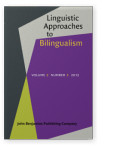Commentary
How linguistic performance may differ across speakers
References (20)
References
Avrutin, S. (2001). Linguistics and agrammatism. GLOT International, 5(3), 1䂿11.
Avrutin, S. (2006). Weak Syntax. In K. Amundt & Y. Grodzinsky (Eds.), Broca’s region. Oxford: Oxford Press. 

Caha, P. (2009). Classical Armenian declension. In P. Svenonius, G. Ramchand, M. Starke, & T. Taraldsen (Eds.), Nordlyd (Vol. 361, special issue on Nanosyntax, pp. 77–112). CASTL, Tromsø. Available from [URL]
Chipere, N. (2001). Native speaker variations in syntactic competence: Implications for first language teaching. Language Awareness, 101, 107–124. 

Chomsky, N. (1965). Aspects of the theory of syntax. Cambridge, MA: MIT Press.
Fodor, J. (1983). The modularity of mind. Cambridge, MA: MIT Press.. 

Gold, E. M. (1967). Language identification in the limit. Information and Control, 161, 447–474. 

Grodzinsky, Y., & Reinhart, T. (1993). The innateness of binding and coreference. Linguistic Inquiry, 241, 69–102.
Halle, M. (1997). Impoverishment and fission. In B. Bruening, Y. Kang, & M. McGinnis (Eds.), Papers at the Interface: MITWPL (Vol. 301, pp. 425–449). Cambridge, MA: MIT.
Jakobson, R. (1962). Beitrag zur allgemeinen Kasuslehre: Gesamtbedeutungen der russischen Kasus. In Selected writings (Vol. 21, pp. 23–71). The Hague: Mouton.
Kolk, H. (2004). Agrammatism. In Raymond Kent (Ed.), The MIT encyclopedia of communication disorders (pp. 231–233). Cambridge, MA: MIT Press.
Koornneef, A. (2008). Eye-catching anaphora. LOT International Dissertation Series, Utrecht University.
Koornneef, A., Avrutin, S., Wijnen, F., & Reuland, E. (2011). Tracking the preference for boundvariable dependencies in ambiguous ellipses and only-structures. In J. Runner (Ed.), Experiments at the interfaces (Syntax and Semantics, Vol. 371). Bingley: Emerald Group Publishing Limited.
Quine, W. (1960). Word and object. Cambridge, MA: MIT Press.
Reinhart, T. (2006). Interface strategies. Cambridge, MA: MIT Press. 

Reuland, E. (2011). Anaphora and language design. Cambridge, MA: MIT Press.
Townsend, D., & Bever,T. (2001). Sentence comprehension: The integration of habits and rules. Cambridge, MA: MIT Press. 

Vasić, N. (2006). Pronoun comprehension in agrammatic aphasia: The structure and use of linguistic knowledge. Doctoral dissertation, LOT, Utrecht University.
Vasić, N., Avrutin, S., & Ruigendijk, E. (2006). Interpretation of pronouns in VP-ellipsis constructions in Dutch Broca’s and Wernicke’s aphasia. Brain and Language, 96(2), 191–206. 

Wexler, K., & Culicover, P. (1980). Formal Principles of Language Acquisition. Cambridge, MA: MIT Press.
Cited by (2)
Cited by two other publications
Koornneef, Arnout & Eric Reuland
2016.
On the Shallow Processing (Dis)Advantage: Grammar and Economy.
Frontiers in Psychology 7

This list is based on CrossRef data as of 5 july 2024. Please note that it may not be complete. Sources presented here have been supplied by the respective publishers.
Any errors therein should be reported to them.
